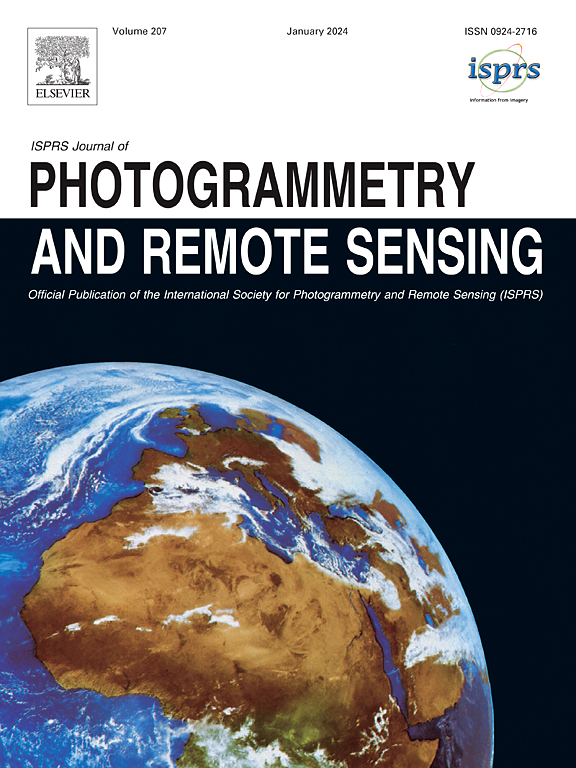基于距离-多普勒模型的多视点星载SAR图像几何自标定方法及稳定性分析
IF 10.6
1区 地球科学
Q1 GEOGRAPHY, PHYSICAL
ISPRS Journal of Photogrammetry and Remote Sensing
Pub Date : 2025-02-01
DOI:10.1016/j.isprsjprs.2025.01.009
引用次数: 0
摘要
合成孔径雷达(SAR)图像定位技术广泛应用于包括土地测绘在内的许多科学领域。如果在三个方向上捕获图像,则可以进行几何自校准。然而,当图像数量过少时,基于距离-多普勒(RD)模型的SAR图像自定标会出现不准确的情况。因此,鲁棒几何标定方法对标定结果有重要影响。这种方法的有效性取决于SAR图像的有效性。这意味着校准可以通过算法优化自校准所涉及的图像,使校准结果接近真实的未知参数。为了克服几何标定中的这些误差,本研究提出了一种灵活的标定方法。利用行列式和精度稳定因子(ASF)对图像进行过滤,允许奇异解的评估并确定SAR图像的有效性。实验结果证明了该方法的鲁棒性。此外,建议将倾斜距离方程作为分析图像校准误差源和图像捕获的主导方程。研究发现,卫星位置是图像标定误差的主要来源。因此,分析了卫星位置和相关入射角对标定的影响。分析表明,卫星捕获入射角大于8°的同侧图像是理想的。这一发现证明了获取SAR图像的合理性。本文章由计算机程序翻译,如有差异,请以英文原文为准。
A sensitive geometric self-calibration method and stability analysis for multiview spaceborne SAR images based on the range-Doppler model
Synthetic aperture radar (SAR) image positioning technology is extensively used in many scientific fields, including land surveying and mapping. Geometric self-calibration can be performed if images are captured in three directions. However, when the number of images is too small, self-calibration of the SAR images based on the range-Doppler (RD) model appears to be inaccurate. Hence, a robust geometric calibration method has an important impact on calibration results. The effectiveness of such a method depends on the validity of the SAR images. This implies that the calibration can algorithmically optimize the images involved in self-calibration such that the calibration results are close to the true unknown parameters. To overcome these inaccuracies in geometric calibration, this study proposes a flexible calibration approach. The determinant and accuracy stabilization factor (ASF) are utilized to filter the images, allowing the evaluation of singular solutions and determining the validity of the SAR images. Experimental results demonstrate that the robustness of the proposed approach. In addition, the slant range equation is suggested as the dominant equation for analyzing image calibration error sources and image capture. It is found that satellite position is the main source of image calibration errors. Therefore, the impact of the satellite position and the associated incidence angle on the calibration is analyzed. The analysis reveals that it is desirable for satellites to capture ipsilateral images with incidence angles greater than 8. This finding justifies the acquisition of SAR images.
求助全文
通过发布文献求助,成功后即可免费获取论文全文。
去求助
来源期刊

ISPRS Journal of Photogrammetry and Remote Sensing
工程技术-成像科学与照相技术
CiteScore
21.00
自引率
6.30%
发文量
273
审稿时长
40 days
期刊介绍:
The ISPRS Journal of Photogrammetry and Remote Sensing (P&RS) serves as the official journal of the International Society for Photogrammetry and Remote Sensing (ISPRS). It acts as a platform for scientists and professionals worldwide who are involved in various disciplines that utilize photogrammetry, remote sensing, spatial information systems, computer vision, and related fields. The journal aims to facilitate communication and dissemination of advancements in these disciplines, while also acting as a comprehensive source of reference and archive.
P&RS endeavors to publish high-quality, peer-reviewed research papers that are preferably original and have not been published before. These papers can cover scientific/research, technological development, or application/practical aspects. Additionally, the journal welcomes papers that are based on presentations from ISPRS meetings, as long as they are considered significant contributions to the aforementioned fields.
In particular, P&RS encourages the submission of papers that are of broad scientific interest, showcase innovative applications (especially in emerging fields), have an interdisciplinary focus, discuss topics that have received limited attention in P&RS or related journals, or explore new directions in scientific or professional realms. It is preferred that theoretical papers include practical applications, while papers focusing on systems and applications should include a theoretical background.
 求助内容:
求助内容: 应助结果提醒方式:
应助结果提醒方式:


